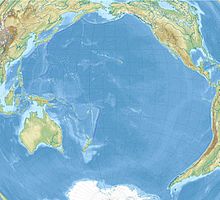Sebastian Lopez Islands
supposed position of the Sebastian Lopez Islands |
The Spanish almirante and piloto mayor José González Cabrera Bueno mentions the Islas de Sebastian Lopez as a group lying on the galleon route from the Philippines to Acapulco below 24 ° 55 'N; 29 ° 13 'E of the Embocadero de San Bernardino (152 ° 58' E from gr.). According to Dahlgren, a Sebastian Lopez island (Isle de Bastian Lop, Isla de Sebastian Lobes, Sebastian Lopez, Juan Lopez) first appeared on Spanish nautical charts of the early 18th century.
Dahlgren assumes that the Sebastian Lopez Island - assuming there was really only one - was named after a Spanish admiral of the same name who excelled in the battles against the Dutch in 1644-45, became a naval hero and died in Manila around 1650 . If so, then the island was named or viewed not long after the middle of the 17th century.
But this is speculation, because all that can be said for sure is that the Sebastian Lopez Islands were first sighted sometime before 1734. Since little can be said about the determination of the longitude of the time in question, only the fact of an island group (Islas) and the northern latitude of 24 ° 55 'remain as fixed points, criteria that only apply to the volcanic islands, today's Japanese Kazan-rettō fulfill.
literature
- Welsch, Bernhard: The asserted discovery of Marcus Island in 1694; in: The Journal of Pacific History , Vol. 36, Iss. 1; Canberra 2001 (pp. 105-115)
Individual evidence
- ^ González Cabrera Bueno, José: Navegación especvlativa y práctica; Manila 1734, p. 275. Lt. Burney is the Embocadero de San Bernardino at 123 ° 45 'E v.Gr. (Burney, James: A chronological history of the discoveries in the South Sea or Pacific Ocean, Vol. 5; London 1817, p. 159, note)
- ^ Dahlgren, Erik Wilhelm: Were the Hawaiian Islands visited by the Spaniards before their discovery by Captain Cook in 1778 ?; in: Kungliga Svenska Vetenskapsakademiens handlingar, Ny Följd, Vol. 57, No. 4; Stockholm 1916, p. 191
- ↑ Dahlgren, p. 100
